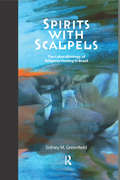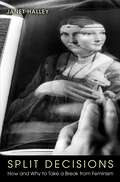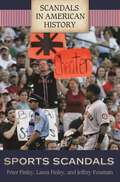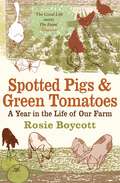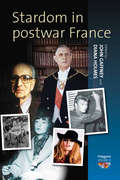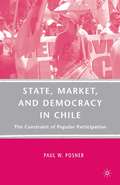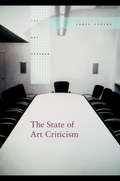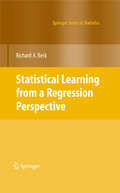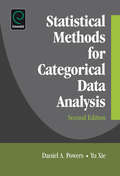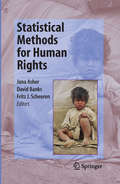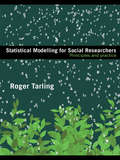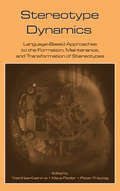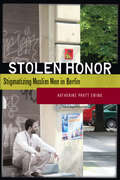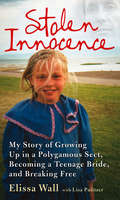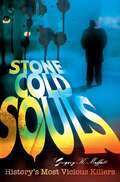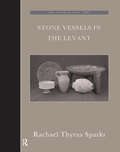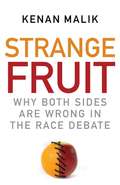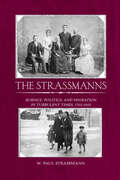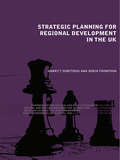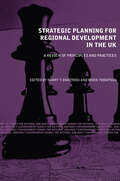- Table View
- List View
Spirits with Scalpels: The Cultural Biology of Religious Healing in Brazil
by Sidney M Greenfield“The first time I witnessed a Spiritist surgery, a young man named Jose Carlos Ribeiro inserted a used scalpel taken from a tray that I was holding, and plunged it into the eye of an elderly man. The patient did not move….” Decades of fieldwork later, Sidney Greenfield presents a riveting ethnography of the complex world of religious healing in Brazil that challenges readers to grapple with the most fundamental concepts of anthropology and cross-cultural experience. In a major contribution to cultural biology, he analyses the complex social, economic, and political landscape of Brazil to understand dramatic healing practices that seem to defy medical explanation. This engrossing and provocative book will put students and scholars alike on the edge of their seats.
Split Decisions: How and Why to Take a Break from Feminism
by Janet HalleyIs it time to take a break from feminism? In this pathbreaking book, Janet Halley reassesses the place of feminism in the law and politics of sexuality. She argues that sexuality involves deeply contested and clashing realities and interests, and that feminism helps us understand only some of them. To see crucial dimensions of sexuality that feminism does not reveal--the interests of gays and lesbians to be sure, but also those of men, and of constituencies and values beyond the realm of sex and gender--we might need to take a break from feminism. Halley also invites feminism to abandon its uncritical relationship to its own power. Feminists are, in many areas of social and political life, partners in governance. To govern responsibly, even on behalf of women, Halley urges, feminists should try taking a break from their own presuppositions. Halley offers a genealogy of various feminisms and of gay, queer, and trans theories as they split from each other in the United States during the 1980s and 1990s. All these incommensurate theories, she argues, enrich thinking on the left not despite their break from each other but because of it. She concludes by examining legal cases to show how taking a break from feminism can change your very perceptions of what's at stake in a decision and liberate you to decide it anew.
Split Decisions: How and Why to Take a Break from Feminism
by Janet HalleyIs it time to take a break from feminism? In this pathbreaking book, Janet Halley reassesses the place of feminism in the law and politics of sexuality. She argues that sexuality involves deeply contested and clashing realities and interests, and that feminism helps us understand only some of them. To see crucial dimensions of sexuality that feminism does not reveal--the interests of gays and lesbians to be sure, but also those of men, and of constituencies and values beyond the realm of sex and gender--we might need to take a break from feminism. Halley also invites feminism to abandon its uncritical relationship to its own power. Feminists are, in many areas of social and political life, partners in governance. To govern responsibly, even on behalf of women, Halley urges, feminists should try taking a break from their own presuppositions. Halley offers a genealogy of various feminisms and of gay, queer, and trans theories as they split from each other in the United States during the 1980s and 1990s. All these incommensurate theories, she argues, enrich thinking on the left not despite their break from each other but because of it. She concludes by examining legal cases to show how taking a break from feminism can change your very perceptions of what's at stake in a decision and liberate you to decide it anew.
Sports Scandals (Scandals in American History)
by Peter Finley Laura L. Finley Jeffrey FountainCheaters, gamblers, drugs, and violence. Sound like the latest action/adventure film? It is most likely playing in a stadium, ice rink, track field, basketball court, or ballpark near you. We're talking about the larger-than-life scandals that often surround and sometimes engulf the world of sports. Covering everything from the little leagues to college and professional sports, this indespensable book offers students an intriguing, readable guide to the most notorious scandals in American sports history.Each chapter focuses on a specific category of scandal, including race-related, gender-related, drug-related, violence-related, recruiting and academic-related, and coaching scandals. Insightful, in-depth entries offer and overview of the historical and cultural context, what occurred and who was involved, as well as the response to the scandal. Entries within chapters clearly outline the diversity of viewpoints surrounding the scandal as well as the associated ethical, moral, and legal issues. Highlighting why sport scandals matter to athletes, to coaches, to teams, to organizations, to the media, and to the public, this volume is an ideal resource for both ready reference and for reading cover-to-cover.
Spotted Pigs and Green Tomatoes: A Year in the Life of Our Farm
by Rosie BoycottAfter leaving the editorship of the Daily Express, Rosie Boycott wasn't sure what to do next. A terrible car accident forced her to rethink her life, turning her in a direction she would never have previously imagined. Working a small farm in Somerset proves a daunting task, but Rosie and her new husband Charlie are determined, and their immersion in rural living, hilarious and profoundly moving, reaps rewards they never expected. Pigs, ducks and geese are fattened for the butcher; vegetables and cut flowers are grown for a reluctant marketplace; and Rosie and Charlie discover much about the hard graft of running a smallholding. They learn too about weightier issues that affect the local community of Ilminster - particularly the new supermarket that threatens the soul of the local town centre. And Rosie finds recovery in the rhythms of the seasons.
Stardom in Postwar France (Polygons: Cultural Diversities and Intersections #12)
by John Gaffney Diana HolmesThe 1950s and 1960s were a key moment in the development of postwar France. The period was one of rapid change, derived from post-World War II economic and social modernization; yet many traditional characteristics were retained. By analyzing the eruption of the new postwar world in the context of a France that was both modern and traditional, we can see how these worlds met and interacted, and how they set the scene for the turbulent 1960s and 70s. The examination of the development of mass culture in post-war France, undertaken in this volume, offers a valuable insight into the shifts that took place. By exploring stardom from the domain of cinema and other fields, represented here by famous figures such as Brigitte Bardot, Johnny Hallyday or Jean-Luc Godard, and less conventionally treated areas of enquiry (politics [de Gaulle], literary [Françoise Sagan], and intellectual culture [Lévi-Strauss]) the reader is provided with a broad understanding of the mechanisms of popularity and success, and their cultural, social, and political roles. The picture that emerges shows that many cultural articulations remained or became identifiably "French," in spite of the American mass-culture origins of these social, economic, and cultural transformations.
State, Market, and Democracy in Chile: The Constraint of Popular Participation
by P. PosnerThrough an in-depth analysis of the Chilean labour market, social welfare, and state reforms, this book reveals the manner in which neoliberal reform in Chile has undermined the urban poor's incentives and ability to hold public officials accountable, negatively affecting the quality of Chilean democracy.
The State of Art Criticism (The Art Seminar #Vol. 4)
by James Elkins Michael NewmanArt criticism is spurned by universities, but widely produced and read. It is seldom theorized and its history has hardly been investigated. The State of Art Criticism presents an international conversation among art historians and critics that considers the relation between criticism and art history and poses the question of whether criticism may become a university subject. Contributors include Dave Hickey, James Panero, Stephen Melville, Lynne Cook, Michael Newman, Whitney Davis, Irit Rogoff, Guy Brett and Boris Groys.
The State of Art Criticism (The Art Seminar)
by James Elkins Michael NewmanArt criticism is spurned by universities, but widely produced and read. It is seldom theorized and its history has hardly been investigated. The State of Art Criticism presents an international conversation among art historians and critics that considers the relation between criticism and art history and poses the question of whether criticism may become a university subject. Contributors include Dave Hickey, James Panero, Stephen Melville, Lynne Cook, Michael Newman, Whitney Davis, Irit Rogoff, Guy Brett and Boris Groys.
Statistical Learning from a Regression Perspective (Springer Series in Statistics)
by Richard A. BerkStatistical Learning from a Regression Perspective considers statistical learning applications when interest centers on the conditional distribution of the response variable, given a set of predictors, and when it is important to characterize how the predictors are related to the response. As a first approximation, this is can be seen as an extension of nonparametric regression. Among the statistical learning procedures examined are bagging, random forests, boosting, and support vector machines. Response variables may be quantitative or categorical. Real applications are emphasized, especially those with practical implications. One important theme is the need to explicitly take into account asymmetric costs in the fitting process. For example, in some situations false positives may be far less costly than false negatives. Another important theme is to not automatically cede modeling decisions to a fitting algorithm. In many settings, subject-matter knowledge should trump formal fitting criteria. Yet another important theme is to appreciate the limitation of one’s data and not apply statistical learning procedures that require more than the data can provide. The material is written for graduate students in the social and life sciences and for researchers who want to apply statistical learning procedures to scientific and policy problems. Intuitive explanations and visual representations are prominent. All of the analyses included are done in R.
Statistical Methods for Categorical Data Analysis
by Daniel Powers Yu XieThis book provides a comprehensive introduction to methods and models for categorical data analysis and their applications in social science research. An explicit aim of the book is to integrate the transformational and the latent variable approach, two diverse but complementary traditions dealing with the analysis of categorical data. This is the first introductory text to cover models and methods for discrete dependent variables, cross-classifications, and longitudinal data in a rigorous, yet accessible, manner in a single volume.The second edition of this book includes new material on multilevel models for categorical data. Several chapters have undergone extensive revisions and extensions to include new applications and examples. Highlights of the 2nd edition include a detailed discussion of classical and Bayesian estimation techniques for hierarchical/multilevel models, extensive coverage of discrete-time hazard models and Cox regression models, and methods for evaluating and accommodating departures from model assumptions. The accompanying website contains programming scripts to replicate each example using various statistical packages, which has proven to be an invaluable resource for instructors, students, and researchers. This book presents the essential methods and models that form the core of contemporary social statistics. The book covers a remarkable range of models that have applications in sociology, demography, psychometrics, econometrics, political science, biostatistics, and other fields. It will be especially useful as a graduate textbook for students in advanced social statistics courses and as a reference book for applied researchers. Companion website also available, at https://webspace.utexas.edu/dpowers/www/
Statistical Methods for Human Rights
by Jana Asher David Banks Fritz J. ScheurenHuman rights issues are shaping the modern world. They define the expectations by which nations are judged and affect the policy of governments, corporations, and foundations. Statistics is central to the modern perspective on human rights. It allows researchers to measure the effect of health care policies, the penetration of educational opportunity, and progress towards gender equality. This book describes the statistics that underlie the social science research in human rights. It includes case studies, methodology, and research papers that discuss the fundamental measurement issues.
Statistical Modelling for Social Researchers: Principles and Practice
by Roger TarlingThis book explains the principles and theory of statistical modelling in an intelligible way for the non-mathematical social scientist looking to apply statistical modelling techniques in research. The book also serves as an introduction for those wishing to develop more detailed knowledge and skills in statistical modelling. Rather than present a limited number of statistical models in great depth, the aim is to provide a comprehensive overview of the statistical models currently adopted in social research, in order that the researcher can make appropriate choices and select the most suitable model for the research question to be addressed. To facilitate application, the book also offers practical guidance and instruction in fitting models using SPSS and Stata, the most popular statistical computer software which is available to most social researchers. Instruction in using MLwiN is also given. Models covered in the book include; multiple regression, binary, multinomial and ordered logistic regression, log-linear models, multilevel models, latent variable models (factor analysis), path analysis and simultaneous equation models and models for longitudinal data and event histories. An accompanying website hosts the datasets and further exercises in order that the reader may practice developing statistical models. An ideal tool for postgraduate social science students, research students and practicing social researchers in universities, market research, government social research and the voluntary sector.
Statistical Modelling for Social Researchers: Principles and Practice
by Roger TarlingThis book explains the principles and theory of statistical modelling in an intelligible way for the non-mathematical social scientist looking to apply statistical modelling techniques in research. The book also serves as an introduction for those wishing to develop more detailed knowledge and skills in statistical modelling. Rather than present a limited number of statistical models in great depth, the aim is to provide a comprehensive overview of the statistical models currently adopted in social research, in order that the researcher can make appropriate choices and select the most suitable model for the research question to be addressed. To facilitate application, the book also offers practical guidance and instruction in fitting models using SPSS and Stata, the most popular statistical computer software which is available to most social researchers. Instruction in using MLwiN is also given. Models covered in the book include; multiple regression, binary, multinomial and ordered logistic regression, log-linear models, multilevel models, latent variable models (factor analysis), path analysis and simultaneous equation models and models for longitudinal data and event histories. An accompanying website hosts the datasets and further exercises in order that the reader may practice developing statistical models. An ideal tool for postgraduate social science students, research students and practicing social researchers in universities, market research, government social research and the voluntary sector.
Stereotype Dynamics: Language-Based Approaches to the Formation, Maintenance, and Transformation of Stereotypes
by Yoshihisa Kashima Klaus Fiedler Peter FreytagThis volume addresses the role of communication in stereotype dynamics, while placing the phenomenon of social stereotypes appropriately in the socio-cultural context. Stereotype Dynamics assembles top researchers in the field to investigate stereotype formation, maintenance, and transformation through interpersonal facets of communication.Section
Stereotype Dynamics: Language-Based Approaches to the Formation, Maintenance, and Transformation of Stereotypes
by Yoshihisa Kashima Klaus Fiedler Peter FreytagThis volume addresses the role of communication in stereotype dynamics, while placing the phenomenon of social stereotypes appropriately in the socio-cultural context. Stereotype Dynamics assembles top researchers in the field to investigate stereotype formation, maintenance, and transformation through interpersonal facets of communication.Section
Stolen Honor: Stigmatizing Muslim Men in Berlin
by Katherine Pratt EwingThe covered Muslim woman is a common spectacle in Western media—a victim of male brutality, the oppressed and suffering wife or daughter. And the resulting negative stereotypes of Muslim men, stereotypes reinforced by the post-9/11 climate in which he is seen as a potential terrorist, have become so prominent that they influence and shape public policy, citizenship legislation, and the course of elections across Europe and throughout the Western world. In this book, Katherine Pratt Ewing asks why and how these stereotypes—what she terms "stigmatized masculinity"—largely go unrecognized, and examines how Muslim men manage their masculine identities in the face of such discrimination. The author focuses her analysis and develops an ethnographic portrait of the Turkish Muslim immigrant community in Germany, a population increasingly framed in the media and public discourse as in crisis because of a perceived refusal of Muslim men to assimilate. Interrogating this sense of crisis, Ewing examines a series of controversies—including honor killings, headscarf debates, and Muslim stereotypes in cinema and the media—to reveal how the Muslim man is ultimately depicted as the "abjected other" in German society.
Stolen Innocence: My Story Of Growing Up In A Polygamous Sect, Becoming A Teenage Bride, And Breaking Free
by Elissa WallA tale of survival and freedom, Stolen Innocence is the story of one heroic woman who stood up for what was right and reclaimed her life.
Stone Cold Souls: History's Most Vicious Killers (Non-ser.)
by Gregory K. MoffattHistory's most notorious and brutal killers still enjoy fame as public fascination with their lives and their crimes continues to grow. Stone Cold Souls is a detailed examination of the most brutal killers in history. Moffatt does what he does best by looking at historical accounts of events, analyzing them from a psychological perspective, and presenting his assessment in captivating fashion. He examines different types of killers, offers case studies and historical context, and describes what sets these cases apart from other kinds of killings. Even in a day and age where pop culture has made serial crime a mainstay of movies and books, the depravity of the killers profiled in this work will still shock even a desensitized reader.Men, women, and children alike have committed crimes so atrocious that it is hard to imagine that these events are not works of fiction. Moffatt examines the difficult questions that inevitably arise when one reads cases of unthinkable torture and cruelty. Why? Were these people simply evil or is it possible that, given other circumstances, they could have redirected their energies into more productive outlets? The author answers these questions and others and reveals the lives and crimes of these ruthless killers.Stone Cold Souls features such well-known cases as: Andrei Chikatilo, Marc Dutroux, Herman Webster Mudgett, Charles Ng, Leonard Lake, Lawrence Bittaker, Roy Norris, Ed Gein, Edmund Kemper, Henry Lee Lucas, Gilles de Rais, Ivan the Terrible, Richard Ramirez, Holly Ann Harvey, Sandy Ketchum, Mary Bell, Jesse Pomeroy, Josef Mengele, Marshall Applewhite, Jeffrey Lundgren, David Koresh, Jim Jones, Father Oliver O'Grady, Charles Cullin, Harold Shipman, Michael Swango, Myra Hindley, Karla Homolka, Aileen Carol Lee Wuornos, Elizabeth Bathory, Charles Sobhraj, Albert Fish, Donald Harvey, and Dennis Rader.
Stone Vessels in the Levant (The Palestine Exploration Fund Annual)
by RachaelThyrza SparksExamining stone vessels in the Levant during the 2nd millennium BC, the author explores the links between material culture and society through a comprehensive study of production and distribution. Extensively illustrated with 100 drawings, maps and charts, this volume includes a full object catalogue.This study represents the first comprehensive overview of the stone vessel assemblagesof the Levant in this period, a time which, fed by an increase of wealth and interregional trade, saw a growth in the popularity and variety of such vessels.Previously, our understanding of the varied functions and forms of these diverse vessels has been relatively underdeveloped. In this volume the author attempts to address this problem by creating a typological framework though which we can analyse variability and define essential characteristics of local stone vessel workshops. Only once this has been achieved is it possible to look at stone vessel production in its wider cultural context. Subsequent chapters explore broader themes, beginning within the workshops themselves, examining the links between craftsmen, their sources of raw materials, and the authorities that controlled and distributed their output. Considerations of the geographical and chronological distribution of such goods are then used to provide a regional perspective for the operation of these workshops, connections between them, and further insights into the nature of local and international trade. Finally, the objects themselves can be used to assess the impact of trends such as the growing Egyptianization of the ruling classes of the Levant at this time.
Stone Vessels in the Levant (The Palestine Exploration Fund Annual)
by RachaelThyrza SparksExamining stone vessels in the Levant during the 2nd millennium BC, the author explores the links between material culture and society through a comprehensive study of production and distribution. Extensively illustrated with 100 drawings, maps and charts, this volume includes a full object catalogue.This study represents the first comprehensive overview of the stone vessel assemblagesof the Levant in this period, a time which, fed by an increase of wealth and interregional trade, saw a growth in the popularity and variety of such vessels.Previously, our understanding of the varied functions and forms of these diverse vessels has been relatively underdeveloped. In this volume the author attempts to address this problem by creating a typological framework though which we can analyse variability and define essential characteristics of local stone vessel workshops. Only once this has been achieved is it possible to look at stone vessel production in its wider cultural context. Subsequent chapters explore broader themes, beginning within the workshops themselves, examining the links between craftsmen, their sources of raw materials, and the authorities that controlled and distributed their output. Considerations of the geographical and chronological distribution of such goods are then used to provide a regional perspective for the operation of these workshops, connections between them, and further insights into the nature of local and international trade. Finally, the objects themselves can be used to assess the impact of trends such as the growing Egyptianization of the ruling classes of the Levant at this time.
Strange Fruit: Why Both Sides are Wrong in the Race Debate (PDF)
by Kenan MalikDebates about race are back and they’re only getting bigger. The US government has licensed a heart drug to be used only on African Americans. A pharmaceutical company is trialling a white-only anti-hepatitis drug. A genetic study claims that Jews are more intelligent because of their history of money lending. There has recently been a massive upsurge in scientific racial research, and in STRANGE FRUIT, Malik reveals this rise is paradoxically due to the efforts of liberal anti-racism; a movement that celebrates human difference over human commonalities. Navigating readers through the historical and scientific thinking on the subject, Malik shows that races are a social construct – they do not actually exist. Stressing that scientists should be allowed to study population differences without the distortions of political race debates, Malik provides a gripping and essential guide to understanding difference in a multicultural world.
The Strassmanns: Science, Politics and Migration in Turbulent Times (1793-1993)
by W. Paul StrassmannAcross six generations and two hundred years, this book tells the story of a German- Jewish family who emigrated from Rawicz, Poland, first to Prussian Berlin, and finally to America. In Berlin they found success in politics, medical science, theatre, and aviation and considered themselves German patriots. With the catastrophe of the First World War and its aftermath, they suffered rejection, threats, and persecution as their fellow citizens became unhinged by Nazism, forcing Strassmanns into exile abroad where they again made their mark and rebuilt successful careers. This book is populated by extraordinary characters, such as Wolfgang, the convicted revolutionary of 1848 who nevertheless led urban reform; by Ernst, who directed the only liberal anti-Nazi resistance movement; and by Antonie, a celebrated actress and transatlantic sports pilot. Strassmann highlights both the large-scale and the very personal dramas of this period in world history. The book is enhanced by many photographs, offering a fascinating document of the fate of a remarkable family.
Strategic Planning for Regional Development in the UK (Natural and Built Environment Series)
by Harry T. Dimitriou Robin ThompsonWith contributions from leading academics and practitioners, Strategic Planning for Regional Development in the UK is the most up-to-date treatment of a fast-changing subject. The book discusses: The evolution of regional planning in the UK and the strategic thinking involved The spatial implications of regional economic development policies The methods and techniques needed for the implementation of strategic planning for regional development How strategic planning for regional development is currently put into practice in three UK regions with different priorities. Strategic Planning for Regional Development in the UK is essential reading for students and academics working within strategic and regional planning and provides policy makers and practitioners with a comprehensive and thought provoking introduction to this critically important emerging field.
Strategic Planning for Regional Development in the UK (Natural and Built Environment Series)
by Harry T. Dimitriou Robin ThompsonWith contributions from leading academics and practitioners, Strategic Planning for Regional Development in the UK is the most up-to-date treatment of a fast-changing subject. The book discusses: The evolution of regional planning in the UK and the strategic thinking involved The spatial implications of regional economic development policies The methods and techniques needed for the implementation of strategic planning for regional development How strategic planning for regional development is currently put into practice in three UK regions with different priorities. Strategic Planning for Regional Development in the UK is essential reading for students and academics working within strategic and regional planning and provides policy makers and practitioners with a comprehensive and thought provoking introduction to this critically important emerging field.
